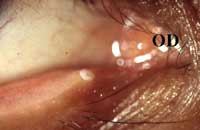Study finds organisms colonized on explanted punctal plugs
The results may prompt surgeons to rethink the causes of eye irritation after punctal plugs are implanted, surgeon says.
|
(Photographs courtesy of Sarkis H. Soukiasian, MD.) |
A retrospective review of 20 explanted punctal plugs showed a high incidence of Pseudomonas aeruginosa and other gram-negative organisms.
Sarkis H. Soukiasian, MD, at the Lahey Clinic in Burlington, Mass., conducted a study to examine the possibility of microbial flora colonization on explanted plugs after he observed the Pseudomonas species on a patient’s explanted plug. His retrospective study evaluated baseline cultures of the eyelid and conjunctiva.
Dr. Soukiasian said punctal plugs are not frequently explanted, but based on the findings of his study, this may be an additional indication for punctal plug removal. He has now explanted several plugs he previously may not have.
There are not many studies in the literature on the microbial flora of punctal plugs. Two other clinical studies by a Japanese group observed gram-positive organisms on explanted plugs, he said.
“Currently, the indications for punctal plug removal are relatively uncommon; however, our findings may make removal more common when patients have clinical symptoms that cannot be explained by other clinical findings,” he said.
Dr. Soukiasian presented his findings at the meeting of the Ocular Microbiology and Immunology Group held at the American Academy of Ophthalmology meeting.
Evidence of colonization
Twenty punctal plugs were explanted from 16 patients. They were implanted for an average of 31.9 months; duration ranged from 2 to 59 months. Positive cultures were obtained from 19 of the plugs. A single organism was identified on 10 plugs, and nine plugs had more than one organism.
The punctal plugs were originally explanted because of increased punctate epithelial stain, localized discomfort, partial extrusion, punctal inflammation or granuloma, epiphora or tearing, conjunctivitis (diffuse or localized), angular blepharitis, recurrent marginal keratitis and corneal ulcer, the latter due to Candida, Dr. Soukiasian said in his presentation.
The causative organisms included Pseudomonas aeruginosa, Staphylococcus aureus, coagulase negative Staphylococcus, alpha hemolytic Streptococcus, Corynebacterium or diphtheroids, Serratia marcescens, Stenotrophomonas maltophila, Klebsiella oxytoca, Klebsiella pneumoniae, Moraxella catarrhalis, Hemophilis, Citrobacter koseri, Aspergillus fumigatus and Candida parapsilosis, with Pseudomonas being the single most common organism identified, he said.
“It doesn’t mean that that patient has an infection. What we found is that at least the plugs themselves had colonization. They can express toxins, which may be irritating to the eye,” he said.
Clinical implications
Dr. Soukiasian observed a high incidence of P. aeruginosa and other gram-negative organisms; such colonization of the plug can cause ocular morbidity. S. epidermidis, diphtheroids and S. aureus are the more common organisms found in the eye, he said. They are usually noninvasive, nonpathogenic aerobic and anaerobic bacteria, which may minimize the colonization of pathogenic organisms.
“We cannot determine if there was a change in the ocular surface microflora or only colonization of the punctal plug. However, the colonized plug alone can be a reservoir of opportunistic pathogens encased in a biofilm,” Dr. Soukiasian said. He told Ocular Surgery News that he is currently conducting a prospective, IRB-approved study, looking at the baseline flora of the lid and conjunctiva and repeating cultures every 3 months for 1 year.
In patients in which there is clinical worsening or mucoid material accumulating on the plug, Dr. Soukiasian removes the plug and performs a culture, and patient therapy is determined on the basis of the clinical response and culture results.
“Exotoxins and endotoxins released from colonized bacteria may also be responsible for some of the clinical symptoms and signs noted,” he said.
Dr. Soukiasian said the results of his study may lead ophthalmologists to reconsider the cause of red eyes after punctal plug implantation. For example, many believe that punctal plugs cause the eye to redden because the eye’s natural irritants are not being flushed or drained. It may also be that the reddening is due to the toxins released from bacteria on the plugs, he said.
Dr. Soukiasian said his findings may suggest a potential risk to patients with punctal plugs who undergo procedures such as LASIK or glaucoma filtration surgery, but this concern is unfounded at the moment.
In studies by N. Yokoi, MD, and J. Sugita, MD, in Japan, the researchers removed punctal plugs from patients undergoing cataract surgery and replaced them after the surgery due to concerns of possible infection, he said.
“One of the important points is that the way we think about eye irritation after punctal plugs are placed in the eye, may need to be revised if this study appears to be correct,” he said.
He said the study may influence industry to investigate materials for punctal plugs that are more resistant to bacteria colonization.
For Your Information:
- Sarkis H. Soukiasian, MD, can be reached at the Lahey Clinic, Department of Ophthlamology, 41 Mall Road, Burlington, MA 01805; 781-744-8555 or 978-538-4430; fax: 781-744-2540 or 978-538-4724; e-mail: soukiasian@lahey.org.


